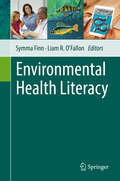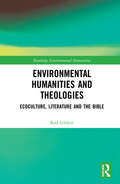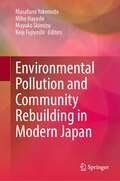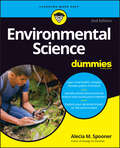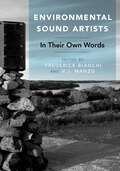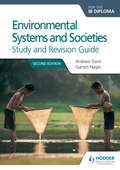- Table View
- List View
Environmental Education in the 21st Century: Theory, Practice, Progress and Promise
by Joy PalmerEnvironmental education is a field characterised by a paradox. Few would doubt the urgency and importance of learning to live in sustainable ways, but environmental education holds nowhere near the priority position in formal schooling around the world that this would suggest. This text sets out to find out why this is so. It is divided into six parts: Part 1 is a concise history of the development of environmental education from an international perspective; Part 2 is an overview of the 'global agenda', or subject knowledge of environmental education; Part 3 introduces perspectives on theory and research in environmental education; Part 4 moves on to practice, and presents an integrated model for planning environmental education programmes; Part 5 brings together invited contributors who talk about environmental education in their own countries - from 15 countries including China, South Africa, Sri Lanka and the USA; Part 6 returns to the core questions of how progress can be made, and how we can maximise the potential of environmental education for the twenty first century.
Environmental Health Literacy
by Symma Finn Liam R. O'FallonThis book explores various and distinct aspects of environmental health literacy (EHL) from the perspective of investigators working in this emerging field and their community partners in research. Chapters aim to distinguish EHL from health literacy and environmental health education in order to classify it as a unique field with its own purposes and outcomes. Contributions in this book represent the key aspects of communication, dissemination and implementation, and social scientific research related to environmental health sciences and the range of expertise and interest in EHL. Readers will learn about the conceptual framework and underlying philosophical tenets of EHL, and its relation to health literacy and communications research. Special attention is given to topics like dissemination and implementation of culturally relevant environmental risk messaging, and promotion of EHL through visual technologies. Authoritative entries by experts also focus on important approaches to advancing EHL through community-engaged research and by engaging teachers and students at an early age through developing innovative STEM curriculum. The significance of theater is highlighted by describing the use of an interactive theater experience as an approach that enables community residents to express themselves in non-verbal ways.
Environmental History and Tribals in Modern India
by Velayutham SaravananThis monograph presents a comprehensive account of environmental history of India and its tribals from the late eighteenth onwards, covering both the colonial and post-colonial periods. The book elaborately discusses the colonial plunder of forest resources up to the introduction of the Forest Act (1878) and focuses on how colonial policy impacted on the Indian environment, opening the floodgates of forest resources plunder, primarily for timber and to establish coffee and tea plantations. The book argues that even after the advent of conservation initiatives, commercial exploitation of forests continued unabated while stringent restrictions were imposed on the tribals, curtailing their access to the jungles. It details how post-colonial governments and populist votebank politics followed the same commercial forest policy till the 1980s without any major reform, exploiting forest resources and also encroaching upon forest lands, pushing the self-sustainable tribal economy to crumble. The book offers a comprehensive account of India’s environmental history during both colonial and post-colonial times, contributing to the current environmental policy debates in Asia.
Environmental Humanities and Theologies: Ecoculture, Literature and the Bible (Routledge Environmental Humanities)
by Rod GiblettMany ways of thinking about and living with ‘the environment’ have their roots in the Bible and the Christian cultural tradition. Environmental Humanities and Theologies shows that some of these ways are problematic. It also provides alternative ways that value both materiality and spirituality. Beginning with an environmentally friendly reading of the biblical story of creation, Environmental Humanities and Theologies goes on to discuss in succeeding chapters the environmental theology of wetlands, dragons and watery monsters (including crocodiles and alligators) in the Bible and literature. It then gives a critical reading of the environmental theology of the biblical book of Psalms. Theological concepts are found in the works of English writers of detective and devotional stories and novels, American nature writers and European Jewish writers (as succeeding chapters show). Environmental Humanities and Theologies concludes with an appreciation for Australian Aboriginal spirituality in the swamp serpent. It argues for the sacrality of marsh monsters and swamp serpents as figures of reverence and respect for living bio- and psycho-symbiotic livelihoods in bioregions of the living earth in the Symbiocene. This is the hoped-for age superseding the Anthropocene. Environmental Humanities and Theologies is aimed at those who have little or no knowledge of how theology underlies much thinking and writing about ‘the environment’ and who are looking for ways of thinking about, being and living with the earth that respect and value both spirituality and materiality. It is a new text nurturing sacrality for the Symbiocene.
Environmental Humanities and Theologies: Ecoculture, Literature and the Bible (Routledge Environmental Humanities)
by Rod GiblettMany ways of thinking about and living with ‘the environment’ have their roots in the Bible and the Christian cultural tradition. Environmental Humanities and Theologies shows that some of these ways are problematic. It also provides alternative ways that value both materiality and spirituality. Beginning with an environmentally friendly reading of the biblical story of creation, Environmental Humanities and Theologies goes on to discuss in succeeding chapters the environmental theology of wetlands, dragons and watery monsters (including crocodiles and alligators) in the Bible and literature. It then gives a critical reading of the environmental theology of the biblical book of Psalms. Theological concepts are found in the works of English writers of detective and devotional stories and novels, American nature writers and European Jewish writers (as succeeding chapters show). Environmental Humanities and Theologies concludes with an appreciation for Australian Aboriginal spirituality in the swamp serpent. It argues for the sacrality of marsh monsters and swamp serpents as figures of reverence and respect for living bio- and psycho-symbiotic livelihoods in bioregions of the living earth in the Symbiocene. This is the hoped-for age superseding the Anthropocene. Environmental Humanities and Theologies is aimed at those who have little or no knowledge of how theology underlies much thinking and writing about ‘the environment’ and who are looking for ways of thinking about, being and living with the earth that respect and value both spirituality and materiality. It is a new text nurturing sacrality for the Symbiocene.
Environmental Law
by Stuart Bell; Donald McGillivray; Ole Pedersen; Emma Lees; Elen StokesTrusted by generations of students and academics alike, the ninth edition of this leading text continues to provide far-reaching coverage of the essential topics taught on most environmental law courses. The authors consider the areas thematically, tackling the key debates and explaining the subject in its social and political context. The clear and accessible writing style ensures that readers are informed yet not overwhelmed. Known for its clear structure and systematic approach, readers new to the subject are provided with a logical introduction while those with more experience can explore the intricacies of the content. The text is supported by a number of learning features designed to help students engage with the material, develop critical thinking skills, and to guide further research. This book is also accompanied by an Online Resource Centre featuring additional chapters, expanded further reading suggestions for each chapter, annotated web links and legal updates.
An Environmental Leader's Tool Kit
by Jeffrey W. HughesIf you want to tackle an environmental problem in your neighborhood but do not know where to start, An Environmental Leader's Tool Kit can help. In this handbook, Jeffrey W. Hughes shares the proven strategies you need to step up and get meaningful action done.From designing a pilot study to managing contentious public meetings and more, Hughes walks you through the essentials of effective place-based environmental efforts. Among the tools you will find here are worksheets to kickstart brainstorming, appendixes that demystify jargon you might encounter, and illuminating, real-life examples. Down-to-earth and stimulating, An Environmental Leader's Tool Kit is a launchpad for those ready to make a difference now.
Environmental Leadership Capacity Building in Higher Education: Experience and Lessons from Asian Program for Incubation of Environmental Leaders
by Takashi Mino and Keisuke HanakiThe Graduate Program in Sustainability Science under the Department of Urban Engineering of The University of Tokyo has been running an environmental leadership education program at the graduate student level since 2007 called the Asian Program for Incubation of Environmental Leaders (APIEL). This book describes the University’s experiences in establishing and organizing that program and provides some lessons learned for those who are considering starting environmental leadership education programs. APIEL’s curriculum includes the classroom topic “Environmental Challenges and Leadership in Asia.” As well, the APIEL program has field units to provide experience in problem solving, decision making, and participation, taking into consideration ecological, political, economic, social, aesthetic, and ethical aspects. Another characteristic feature of the program is that it promotes changes in attitudes and behavior that will help to solve existing environmental problems and to avoid a generation of new ones. Over the four years of study, efforts have been made to bond leadership with field-oriented exercises such as: 1) The Intensive Program on Sustainability; 2) an integral approach focused on sustainable integrated watershed management of arid regions; 3) sustainable development of programs in Cambodia, Vietnam, and Thailand for qualifying students with problem-solving processes to combat issues such as flooding, lack of proper urban environmental infrastructure, and health risks; and 4) the Greater Pearl River Delta program with multicultural diversity to bring about sustainable urban development for a green city. All of those are described in the book. Last but not least, APIEL’s resonance throughout international networks and alumni are introduced.
Environmental Learning: Insights from research into the student experience
by Mark Rickinson Cecilia Lundholm Nick HopwoodEnvironmental education and education for sustainable development have become features of many countries’ formal education systems. To date, however, there have been few attempts to explore what such learning looks and feels like from the perspective of the learners. Based on in-depth empirical studies in school and university classrooms, this book presents rich insights into the complexities and dynamics of students’ environmental learning. The authors show how careful analysis of students’ environmental learning experiences can provide powerful pointers for future practice, policy and research. Environmental Learning will be a key resource for educators, teacher educators, decision-makers and researchers involved in education and sustainable development.
Environmental Learning for Classroom and Assembly at KS1 & KS2: Stories about the Natural World
by Mal Leicester Denise TaylorIn Environmental Learning for Classroom and Assembly at KS1 & KS2, the highly successful and popular author Mal Leicester teams up with the conservationist Denise Taylor to teach children about wildlife and environmental conservation through the art of storytelling. Reflecting the child’s world, the book works outwards from home to garden to neighbourhood to the countryside and seaside and to the planet as a whole. At each level, appreciating, conserving, and enhancing our environment is considered. The authors follow the tried and tested format of Stories for Classroom and Assembly and Stories for Circle Time and Assemblies. Each of the ten chapters includes an original themed story and is packed with lesson plans and cross-curriculum learning activities designed to save teachers’ valuable time. Leicester and Taylor combine the wonder of storytelling with topical environmental issues, covering plants, creatures and the planet. The book covers the full range of conservation, protection and enhancement themes, concepts and values whilst developing the following skills: literacy (including oracy) numeracy knowledge of the natural world imaginative development creative expression. Making a highly topical and on-going subject accessible to children, this beautifully illustrated resource offers teachers assembly ideas, lesson plans and art activities all in one book.
Environmental Learning for Classroom and Assembly at KS1 & KS2: Stories about the Natural World
by Mal Leicester Denise TaylorIn Environmental Learning for Classroom and Assembly at KS1 & KS2, the highly successful and popular author Mal Leicester teams up with the conservationist Denise Taylor to teach children about wildlife and environmental conservation through the art of storytelling. Reflecting the child’s world, the book works outwards from home to garden to neighbourhood to the countryside and seaside and to the planet as a whole. At each level, appreciating, conserving, and enhancing our environment is considered. The authors follow the tried and tested format of Stories for Classroom and Assembly and Stories for Circle Time and Assemblies. Each of the ten chapters includes an original themed story and is packed with lesson plans and cross-curriculum learning activities designed to save teachers’ valuable time. Leicester and Taylor combine the wonder of storytelling with topical environmental issues, covering plants, creatures and the planet. The book covers the full range of conservation, protection and enhancement themes, concepts and values whilst developing the following skills: literacy (including oracy) numeracy knowledge of the natural world imaginative development creative expression. Making a highly topical and on-going subject accessible to children, this beautifully illustrated resource offers teachers assembly ideas, lesson plans and art activities all in one book.
Environmental Liberation Education: Diversity, Mindfulness, and Sustainability Tools for Teachers and Students
by Micaela RubalcavaEnvironmental Liberation Education offers an easy-to-use, culturally responsive, and student-centered teaching approach to academic engagement and systemic change. It explains social-emotional tools and inquiry practices to discuss, reflect, and act for superdiverse student success, happiness, and global citizenship in a challenging, biodiverse world.The book presents three Transformative Tools: Diversity Circles to organize, Multicultural Mindfulness to process, and Approach-in-Dimension to assess. The Tools show educators at all levels across disciplines how to reduce bias and make sustainability decisions daily. They empower teachers to develop peace for academic concentration in busy classrooms through a holistic understanding of body, mind, culture, and environment. The book offers a range of classroom-based and professional development exercises for critical consciousness, including mindfulness practices, transformative journal worksheets, cultural actions, and a self-survey to establish a baseline for hands-on diversity, well-being, and sustainability competencies.Synthesizing multicultural and environmental education through mindfulness practices, Environmental Liberation Education is an invaluable resource for educators-in-training and practicing teachers.
Environmental Liberation Education: Diversity, Mindfulness, and Sustainability Tools for Teachers and Students
by Micaela RubalcavaEnvironmental Liberation Education offers an easy-to-use, culturally responsive, and student-centered teaching approach to academic engagement and systemic change. It explains social-emotional tools and inquiry practices to discuss, reflect, and act for superdiverse student success, happiness, and global citizenship in a challenging, biodiverse world.The book presents three Transformative Tools: Diversity Circles to organize, Multicultural Mindfulness to process, and Approach-in-Dimension to assess. The Tools show educators at all levels across disciplines how to reduce bias and make sustainability decisions daily. They empower teachers to develop peace for academic concentration in busy classrooms through a holistic understanding of body, mind, culture, and environment. The book offers a range of classroom-based and professional development exercises for critical consciousness, including mindfulness practices, transformative journal worksheets, cultural actions, and a self-survey to establish a baseline for hands-on diversity, well-being, and sustainability competencies.Synthesizing multicultural and environmental education through mindfulness practices, Environmental Liberation Education is an invaluable resource for educators-in-training and practicing teachers.
Environmental Pollution and Community Rebuilding in Modern Japan
by Masafumi Yokemoto Miho Hayashi Mayuko Shimizu Keiji FujiyoshiThis book describes how modern industry affected people in Japan and their communities by polluting their living environment with toxic emissions. It also shows how the populace endeavored not only to restore their once-clean environment but also to rebuild communities that had been damaged by pollution and its accompanying effects. Environmental pollution is usually referred to in Japan as kogai, public damage, meaning that such pollution not only harms the physical environment—air, water, soil, and the human body—but also destroys the social and personal relationships in the polluted area. Those people who took action recognized that industrial and economic development had been given the highest national priority even at the cost of their health and welfare. In this sense, anti-kogai movements led them to alternative community development and to rethinking what kind of environment and community they wanted. This book also explores the efforts driven by residents in several parts of Japan after the middle of the twentieth century and the endeavors of museums and archives as a memorial to those who suffered from the pollution and for the prospect of a better society with a good environment.
Environmental Portraiture: A Complete Guide to the Portrait Photographer’s Most Powerful Imaging Tool
by Jim CornfieldThis unique book is a photographer’s guide to the powerful medium of the environmental portrait. It explores in lucid detail the many "moving parts" of this imaging style, including the techniques and creative processes that drive some of this genre’s finest contemporary practitioners. In Environmental Portraiture, author Jim Cornfield puts his readers behind the viewfinder to help them successfully master what he calls "the portrait photographer’s most high-powered tool." In a series of detailed tutorial chapters and study models, Cornfield unpacks every practical aspect of the environmental portrait scenario, including research, location scouting, lighting interior and exterior environments, props and wardrobe, lens selection, composition, color, and after-capture. Along with this wealth of comprehensive nuts-and-bolts information, the book probes the deep structure of environmental portraiture—the blend of a sitter’s backstory with the meaningful visual clues in their surroundings. He introduces such concepts as "portraitcraft," "cognitive weight," and "the ideas and emotions quotient," among the many dimensions of an environmental portrait that create eye-opening revelations about the person in front of your lens. A separate section of the book is devoted to a prestigious roster of contemporary environmental portraitists, specifically recruited for this book to explore in-depth selected samples from their diverse portfolios. They bring with them a score of insights, tips and fascinating anecdotes that demonstrate their individualized approaches to this versatile branch of the photographer’s craft. Written for professionals, amateurs and serious students of photography, this book is both a guide and inspiration to creating powerful, communicative environmental portraiture.
Environmental Portraiture: A Complete Guide to the Portrait Photographer’s Most Powerful Imaging Tool
by Jim CornfieldThis unique book is a photographer’s guide to the powerful medium of the environmental portrait. It explores in lucid detail the many "moving parts" of this imaging style, including the techniques and creative processes that drive some of this genre’s finest contemporary practitioners. In Environmental Portraiture, author Jim Cornfield puts his readers behind the viewfinder to help them successfully master what he calls "the portrait photographer’s most high-powered tool." In a series of detailed tutorial chapters and study models, Cornfield unpacks every practical aspect of the environmental portrait scenario, including research, location scouting, lighting interior and exterior environments, props and wardrobe, lens selection, composition, color, and after-capture. Along with this wealth of comprehensive nuts-and-bolts information, the book probes the deep structure of environmental portraiture—the blend of a sitter’s backstory with the meaningful visual clues in their surroundings. He introduces such concepts as "portraitcraft," "cognitive weight," and "the ideas and emotions quotient," among the many dimensions of an environmental portrait that create eye-opening revelations about the person in front of your lens. A separate section of the book is devoted to a prestigious roster of contemporary environmental portraitists, specifically recruited for this book to explore in-depth selected samples from their diverse portfolios. They bring with them a score of insights, tips and fascinating anecdotes that demonstrate their individualized approaches to this versatile branch of the photographer’s craft. Written for professionals, amateurs and serious students of photography, this book is both a guide and inspiration to creating powerful, communicative environmental portraiture.
Environmental Science For Dummies
by Alecia M. SpoonerAce your environmental science class and get smart about the environment Environmental Science For Dummies is a straightforward guide to the interrelationships of the natural world and the role that humans play in the environment. This book tracks to a typical introductory environmental science curriculum at the college level—and is great as a supplement or study guide for AP Environmental Science, too. Uncover fascinating facts about the earth’s natural resources and the problems that arise when resources like air, water, and soil are contaminated by pollutants. If you’re in need of extra help for a class, considering a career in environmental science, or simply care about our planet and want to learn more about helping the environment, this friendly Dummies resource is a great place to start. The key concepts of environmental science, clearly explained All about the changing climate, including new understanding of methane release in the arctic Earth’s natural resources and the importance of protecting them A new chapter on environmental justice, where issues of poverty and sustainability intersectA solid foundation in environmental science is essential for anyone looking for a career in the field—and is important knowledge for all of us as we work together to build a sustainable future.
Environmental Science For Dummies
by Alecia M. SpoonerAce your environmental science class and get smart about the environment Environmental Science For Dummies is a straightforward guide to the interrelationships of the natural world and the role that humans play in the environment. This book tracks to a typical introductory environmental science curriculum at the college level—and is great as a supplement or study guide for AP Environmental Science, too. Uncover fascinating facts about the earth’s natural resources and the problems that arise when resources like air, water, and soil are contaminated by pollutants. If you’re in need of extra help for a class, considering a career in environmental science, or simply care about our planet and want to learn more about helping the environment, this friendly Dummies resource is a great place to start. The key concepts of environmental science, clearly explained All about the changing climate, including new understanding of methane release in the arctic Earth’s natural resources and the importance of protecting them A new chapter on environmental justice, where issues of poverty and sustainability intersectA solid foundation in environmental science is essential for anyone looking for a career in the field—and is important knowledge for all of us as we work together to build a sustainable future.
Environmental Sound Artists: In Their Own Words
Environmental Sound Artists: In Their Own Words is an incisive and imaginative look at the international environmental sound art movement, which emerged in the late 1960s. The term environmental sound art is generally applied to the work of sound artists who incorporate processes in which the artist actively engages with the environment. While the field of environmental sound art is diverse and includes a variety of approaches, the art form diverges from traditional contemporary music by the conscious and strategic integration of environmental impulses and natural processes. This book presents a current perspective on the environmental sound art movement through a collection of personal writings by important environmental sound artists. Dismayed by the limitations and gradual breakdown of contemporary compositional strategies, environmental sound artists have sought alternate venues, genres, technologies, and delivery methods for their creative expression. Environmental sound art is especially relevant because it addresses political, social, economic, scientific, and aesthetic issues. As a result, it has attracted the participation of artists internationally. Awareness and concern for the environment has connected and unified artists across the globe and has achieved a solidarity and clarity of purpose that is singularly unique and optimistic. The environmental sound art movement is borderless and thriving.
ENVIRONMENTAL SOUND ARTISTS C: In Their Own Words
by V. J. Manzo Frederick BianchiEnvironmental Sound Artists: In Their Own Words is an incisive and imaginative look at the international environmental sound art movement, which emerged in the late 1960s. The term environmental sound art is generally applied to the work of sound artists who incorporate processes in which the artist actively engages with the environment. While the field of environmental sound art is diverse and includes a variety of approaches, the art form diverges from traditional contemporary music by the conscious and strategic integration of environmental impulses and natural processes. This book presents a current perspective on the environmental sound art movement through a collection of personal writings by important environmental sound artists. Dismayed by the limitations and gradual breakdown of contemporary compositional strategies, environmental sound artists have sought alternate venues, genres, technologies, and delivery methods for their creative expression. Environmental sound art is especially relevant because it addresses political, social, economic, scientific, and aesthetic issues. As a result, it has attracted the participation of artists internationally. Awareness and concern for the environment has connected and unified artists across the globe and has achieved a solidarity and clarity of purpose that is singularly unique and optimistic. The environmental sound art movement is borderless and thriving.
Environmental Sustainability and Education for Waste Management: Implications for Policy and Practice (Education for Sustainability)
by Winnie Wing Mui So Cheuk Fai Chow John Chi Kin LeeThis book focuses on education for environmental sustainability, in particular the area of solid waste management. Presenting the latest studies from different countries, industries and education sectors on the approaches and innovative ideas to educate future citizens regarding sustainable development of our planet, it is of interest to educators, academics, tertiary students, policy-makers, environmental scientists, social scientists and practitioners who have been involved in education, policy, science, and technological innovation for solid waste management.
Environmental Sustainability Education for a Changing World
by Erika Pénzesné Kónya Martin Haigh Josef KřečekGlobally, there is a need to promote and empower practical action towards better environmental conservation and greater sustainability; education aspires to achieve and motivate this – one mind at a time. This book advances a future-oriented vision of the development of environmental sustainability education in settings outside the high-school. It provides practical guidance for teacher practitioners and policy makers in community-oriented environmental sustainability education. It promotes a modern holistic approach to sustainability learning in and by the community through participative engagement with sustainability issues. Its special foci include working with volunteers and citizen scientists, through museums or through re-purposing Higher Education. Its approach emphasises the implementation of the United Nation’s Sustainable Development Goals and cooperation with environmental management professionals. This book’s cosponsors include the International Association for Headwater Control and FAO – European Forestry Commission’s Working Party on the Management of Mountain Watersheds, as well as the International Environmental Education Conferences, Eger, Hungary and the Hungarian Academy of Science’s Subcommittee on Future Studies. Community education has long been a goal for environmental management, whose practitioners realise that interventions, such as biodiversity conservation, are only truly sustainable when supported by the local land-user and stakeholder communities; this depends upon these stakeholders’ understanding why intervention is necessary.
Environmental Systems and Societies for the IB Diploma Study and Revision Guide: Second edition
by Andrew Davis Garrett NagleStretch your students to achieve their best grade with these year round course companions; providing clear and concise explanations of all syllabus requirements and topics, and practice questions to support and strengthen learning. - Consolidate revision and support learning with a range of exam practice questions and concise and accessible revision notes- Practise exam technique with tips and trusted guidance from examiners on how to tackle questions- Focus revision with key terms and definitions listed for each topic/sub topic
The Environmental Toolkit for Teachers: First Steps to Sustainability
by Neil FraserThe Environmental Toolkit for Teachers is the essential guide to reducing your school's ecological footprint and creating and embedding a sustainability ethos. Whether you are a teacher eager to make your classroom a more eco-friendly environment or a head teacher who wants to set up a whole school project, there are practical strategies and activities in this book for you.Written by an expert environmental education, this book includes 75 eco-projects and lessons that cover how to manage litter, waste and energy efficiently in a time saving, cost effective manner. Each project is tried and tested and includes a step-by-step guide, case studies and examples. There is also advice on how to monitor and evaluate your projects. A key part of the book is the focus on getting students involved in the projects in order to educate them on the ever-increasing importance of living in an environmentally friendly and sustainable community.The Environmental Toolkit for Teachers is an invaluable resource for buy teachers eager to get their school sustainability up to scratch and become the best Eco-Teacher they can be.
The Environmental Toolkit for Teachers: First Steps to Sustainability
by Neil FraserThe Environmental Toolkit for Teachers is the essential guide to reducing your school's ecological footprint and creating and embedding a sustainability ethos. Whether you are a teacher eager to make your classroom a more eco-friendly environment or a head teacher who wants to set up a whole school project, there are practical strategies and activities in this book for you.Written by an expert environmental education, this book includes 75 eco-projects and lessons that cover how to manage litter, waste and energy efficiently in a time saving, cost effective manner. Each project is tried and tested and includes a step-by-step guide, case studies and examples. There is also advice on how to monitor and evaluate your projects. A key part of the book is the focus on getting students involved in the projects in order to educate them on the ever-increasing importance of living in an environmentally friendly and sustainable community.The Environmental Toolkit for Teachers is an invaluable resource for buy teachers eager to get their school sustainability up to scratch and become the best Eco-Teacher they can be.

